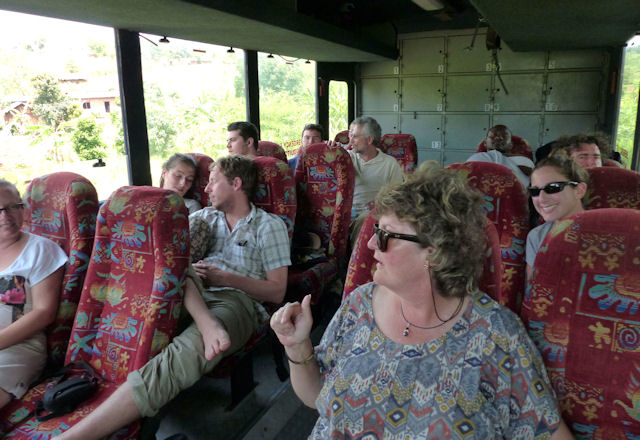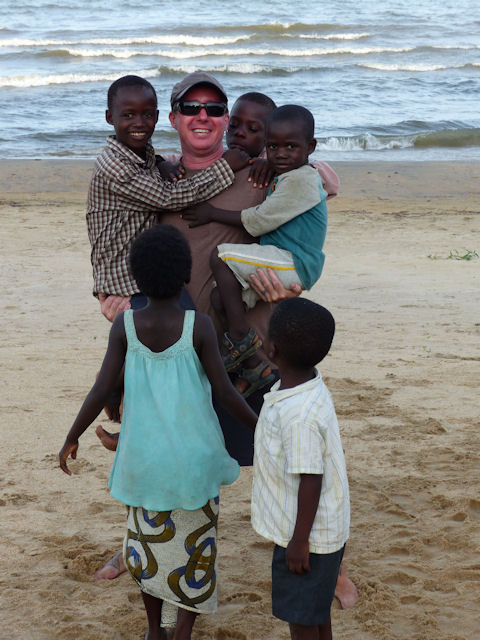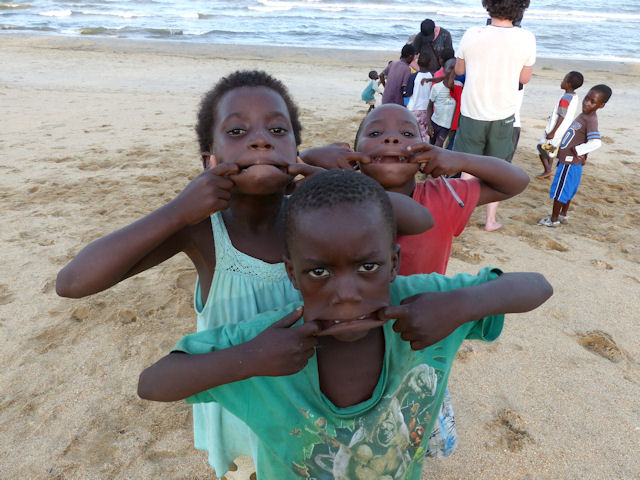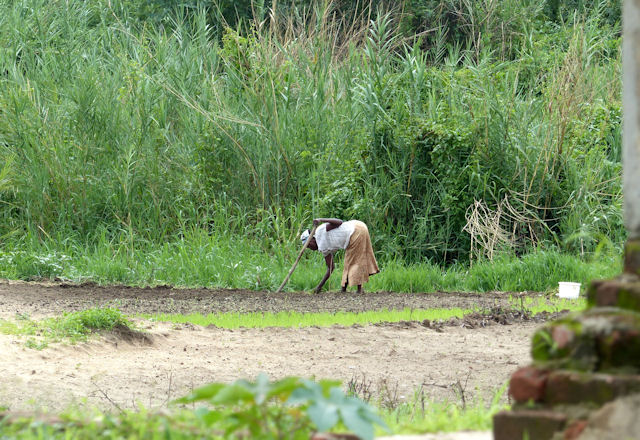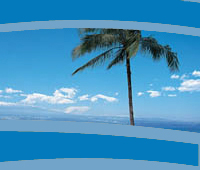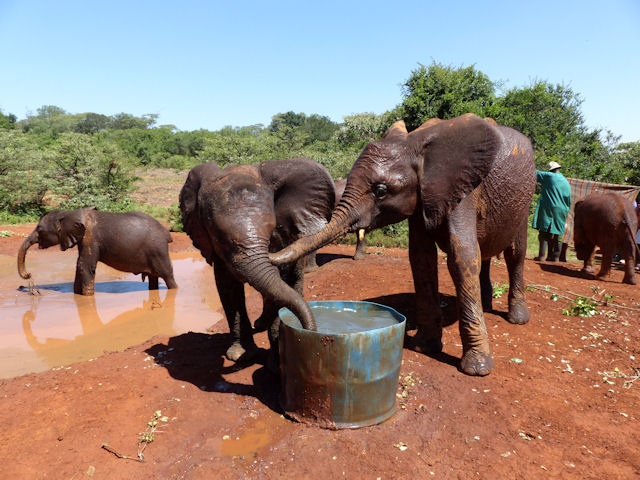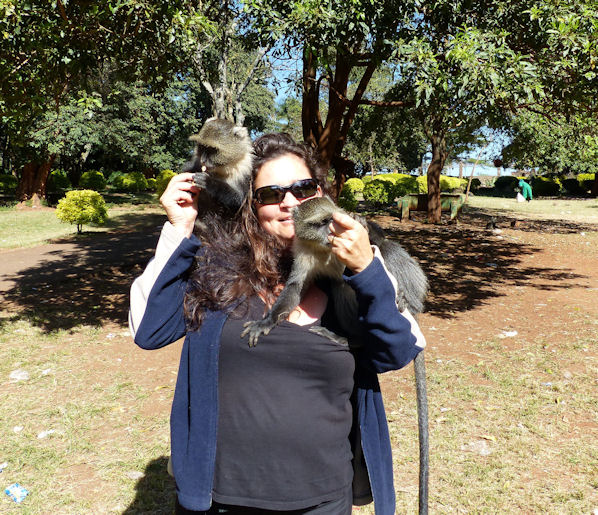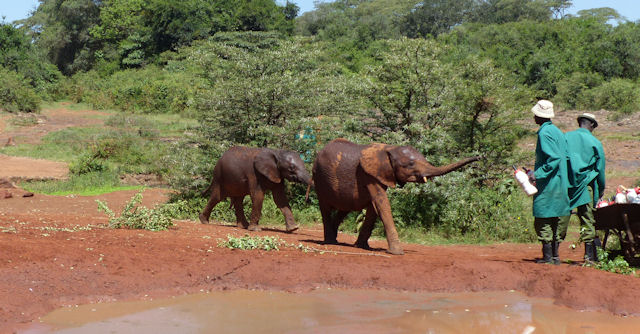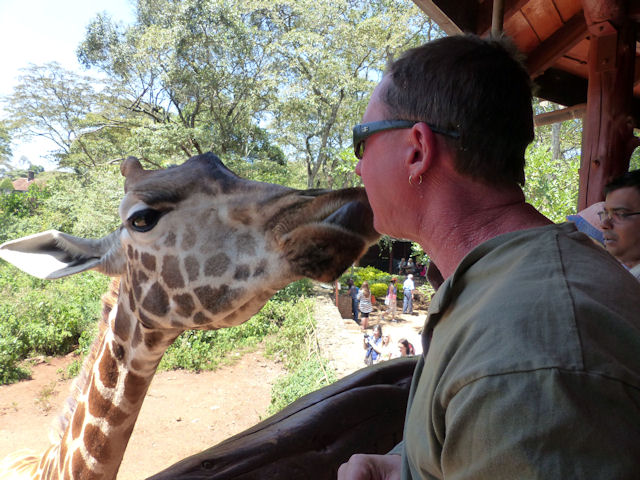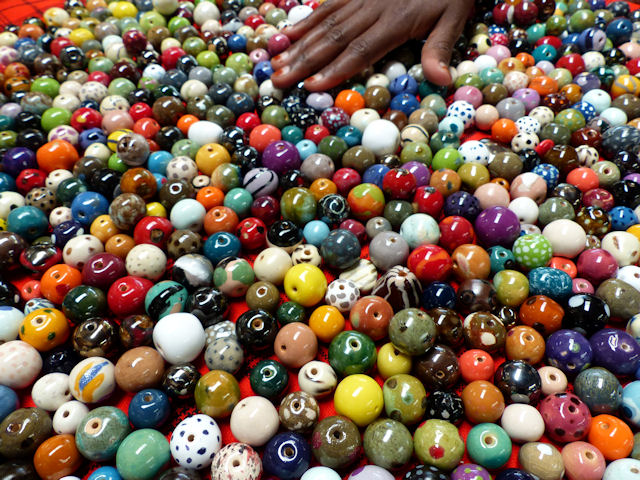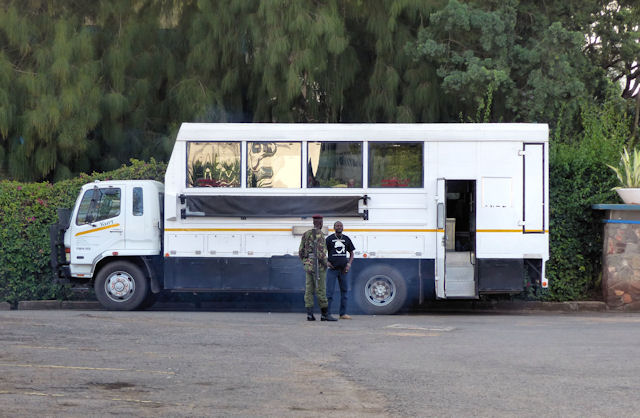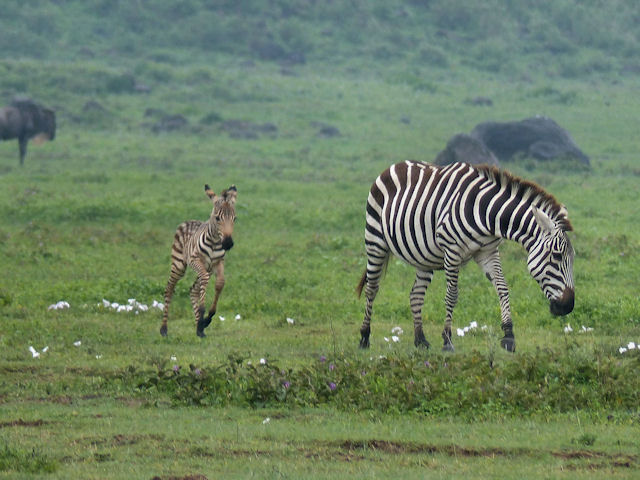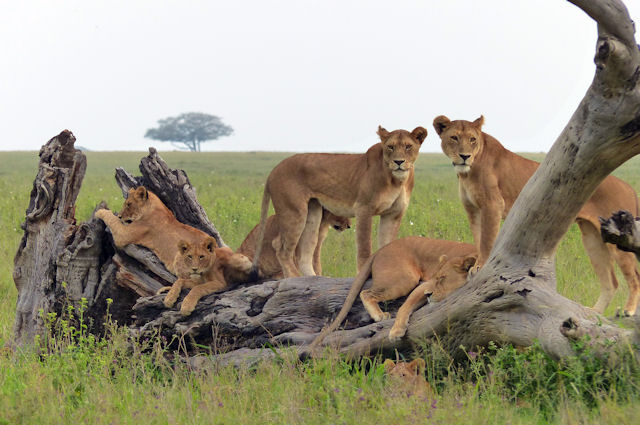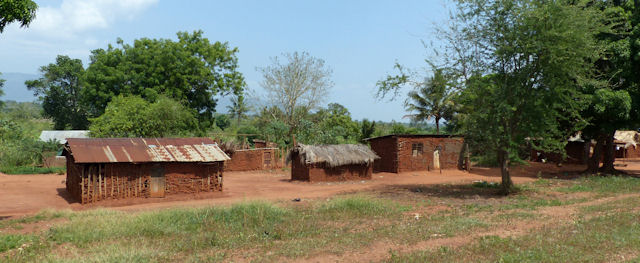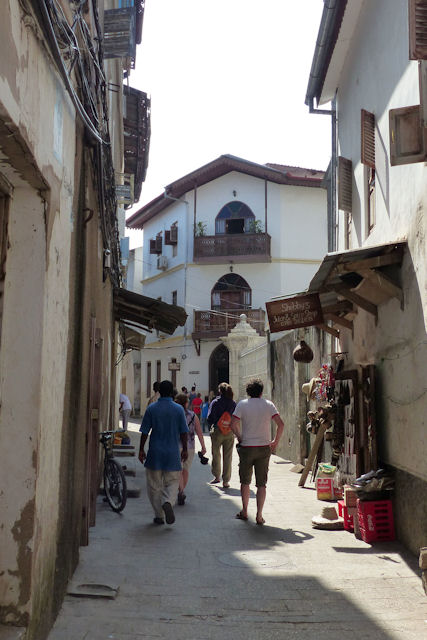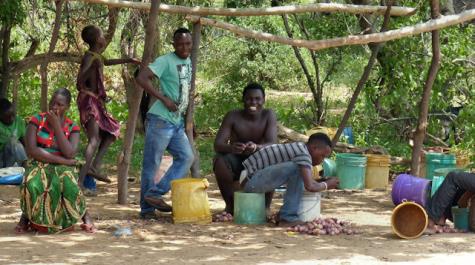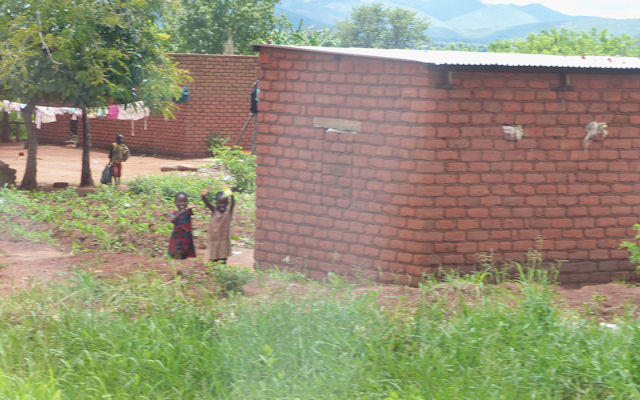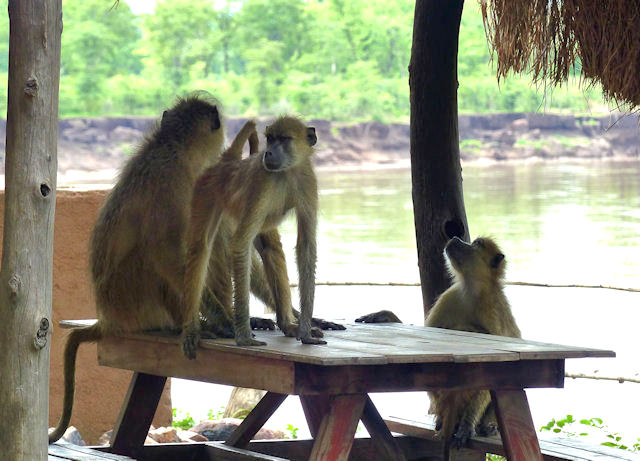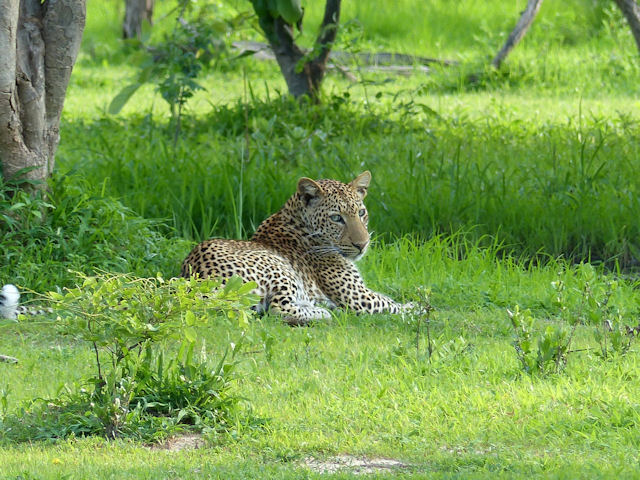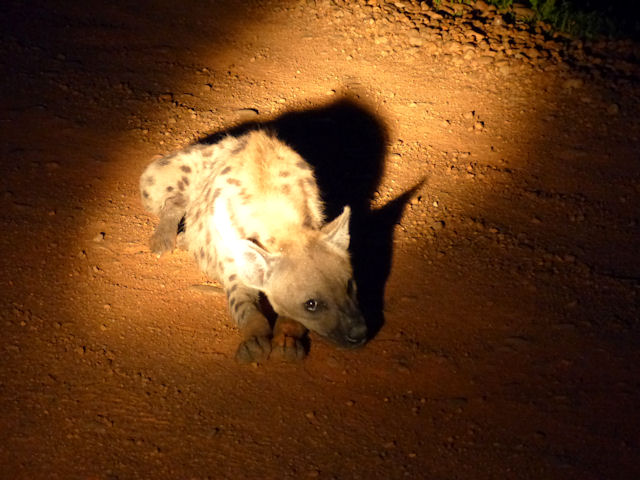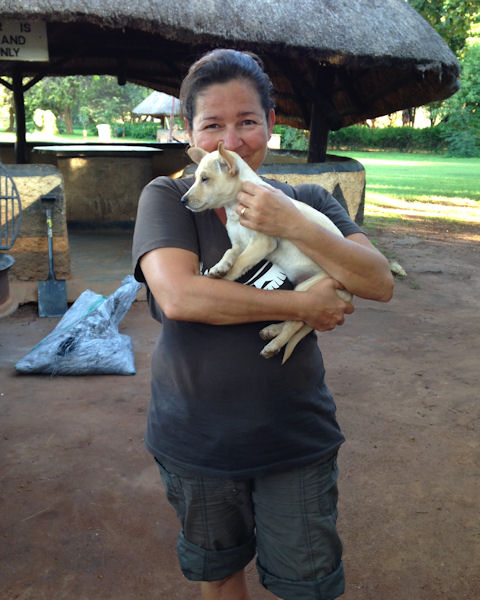15-19 January 2015… Pole Pole in Malawi
This trip involved a lot of border crossings and it was different each time. Sometimes we walked across, sometimes we drove through in the truck. Sometimes there were visas to pay for, at other times it was free. We were tested for Ebola, had our paperwork checked for Yellow Fever and we often had to walk and drive across treated mats to prevent the spread of hoof & mouth disease (this meant unpacking all your shoes!). On a few occasions, we had to hide our meats and vegetables so they weren’t confiscated which called for covert ops (the “locker shuffle”). But the border crossing into Malawi was the real challenge –well, for Thabi anyway. We individuals went through without a hitch but Thabi had a headache getting Kurt across and without him, we were stuck! It all boiled down to the fact that their systems were down and they wouldn’t allow the fees to be paid in cash even though we watched other vehicles being ushered through. So poor Thabi was embroiled in a bureaucratic nightmare while we all hung out outside, chatting amongst ourselves.
Travis, in the meantime, was hanging out with two local guys discussing the value of their wives. One guy had paid five cows for his wife and the other baulked that he had paid far too much! Guy #1 said that it wasn’t possible to get a good wife for the mere three cows he (Guy #2) had paid… and so on. Of course, we all know where this is going. When I asked Travis how many cows I was worth, he thought he had it in the bag. I would be worth at least five cows, he beamed, and when I protested he pushed on by pointing out that my dad is a cattle man and that if they were good angus cows (not those pesky hay-burner cows) then five should be plenty. Naturally, the right answer would have been “cows -infinity” as one of our fellow travellers so accurately pointed out and we got plenty of miles out of this indeed.
Malawi is a beautifully green country and it’s called “The Warm Heart of Africa” because its people are deemed to be the friendliest and that turned out to be so true. Of all the countries we visited, we felt the most warmly and genuinely received here. Ironically, it’s also the poorest country we visited and it’s amazing how happy the people are considering how little they have. We stopped at a supermarket and found it expensive by our standards and it left us wondering how the locals afford it but most of them don’t: they live solely off the food they grow and have small marketplaces within their own communities. This is not the first time we’ve been struck by how happy people are living solely off the fruits of their own labour and it left us wondering again if our abundance of “stuff” in the western world doesn’t make us more unhappy than anything. It certainly makes me appreciate all the more our simple lifestyle aboard the boat. Don’t get me wrong: by no means does it compare to someone living in a mud hut getting by on subsistence farming. But you know what I mean. We do live more simply than most.
After three hours of standing around we were finally with-truck and on our way. It had been a long day but again for us it seemed like small beans as we go through this with every country we visit on the boat –and it’s different every time. On one recent occasion, remember, we had to wait 3 DAYS for customs & immigration to come and clear us in!! In all fairness, though, we did have rum onboard which always eases tensions considerably.
(A typical day on the truck)
Otherwise our few days on the lake were mainly about relaxing and getting off the road for a bit. “Pole pole” as the locals say –“slowly!” We swam, we chilled, we lounged and on our last night we had a roaring fire on the beach until we got rained out. I’d say it’s a good thing we had quality tents but in all truth we were very lucky with the precipitation considering we were heading into the wet season. It really didn’t hamper us at all.
The following morning we were off again but with the truck a bit lighter as our group of four Australians decided to skip ahead to Victoria Falls to maximize their time there. For them it would be the end of their trip and there was much bungee jumping, white-water rafting and abseiling to be done before getting on that plane home! For the remaining 9 of us it was a day’s travel to the capital of Lilongwe. We stopped along the side of the road at a rubber plantation -it’s collected from the trees like sap- and then again at more trees but this time with historical significance. This area was a significant slave trade route -about 20,000 souls passed through here per year- and the famous Dr. David Livingstone arrived in an effort to abolish it and establish legitimate commerce and trade. Two massive fig trees still stand where he met with the traders and local chiefs in the mid-1860s and they came to the agreement to end slavery and the bad blood between them.
As we made our way further south we began to see evidence of the recent flooding we’d been hearing about -and the worst areas were further south still. With so many families living on the brink, you have to wonder what kind of impact this show of Mother Nature has on their livelihood. Water underfoot in your home is one thing but a flooded garden could mean the difference between making it and not. We camped for lunch on the banks of a muddy river that was obviously swollen much past its regular capacity. We were off the beaten track but we still had an audience during our mealtime and it was uncomfortable. For us, it was a few veggies with some cheese and mystery meat crammed between two slices of bread. For them it must have been a veritable feast as we ate with eyes upon us the whole time. The Nomad staffers are great though, and nothing goes to waste. Leftovers are always handed out and in this instance they were actually snatched and fought over. One man made off with the bulk of it, refusing to share, and our guys busted out another loaf of bread to pass among those remaining, most of them just teenagers. It was very sad and while it wasn’t discussed, I think the whole scene made most of us rethink a second helping.
Once having arrived in Lilongwe we had an hour or so to browse the local craft market and we bolstered ourselves for it. Some of the most aggressive salespeople on earth were rendered even more persistent by the fact that they had been rained out and many of them hadn’t made a single sale by mid-afternoon. Or so they said. Of course you have to take it with a grain of salt for they all have their stories of how their wares are meticulously hand-painted/carved/woven and you, his brother/sister will get the very best price for his first/last/only/day-of-the-week sale. While you can appreciate that they’re just making a living the fact of the matter is that every one of these guys is selling the same prefab stuff (some of it from China) so if they don’t catch you first, you might well make your purchase further down the line rather than coming back so they’ll do just about anything to get your attention. Add the fact that we’re obviously tourists who can be soaked for a few extra kwacha and it’s game-on. We were initially impressed by one guy who boasted the “no pressure” approach but in the end was just as aggressive as the rest. So you’re probably wondering why we bothered but we do do our best to support the local economy and we hadn’t yet been to a market in this country; and sometimes, just sometimes, you happen to stumble across something that’s of better quality or perhaps completely unique. Travis made his one purchase and we ran away back to the truck only to find two vendors in the parking lot trying to pry money out of our friends. Exhausted, we boarded the truck and headed to our last campground in this country.
Lake Malawi is 570km long by about 75km at its widest point making it the tenth largest lake in the world at 29,600 square kms. Given its considerable size it takes up a large portion of this tiny country even if a quarter of it belongs to Mozambique. Indeed, the sheer vastness of it more resembles the ocean as unpredictable gales sometimes occur and I was surprised by the wave action along the shoreline. Needless to say, it’s a popular attraction for tourists as it offers beautiful beaches and a host of water-based activities to pass the time. While we stayed at campsites on the beach along Lake Malawi for three nights our highlight actually had nothing to do with the water but rather a visit to a local village. Johnny was our guide and he introduced us to his family and neighbours, giving us some insight into their daily lives and everyone was so friendly. They showed us how they catch and dry their fish and we were walked through their gardens and past their animal pens. They have a medical centre and a school and we came equipped with pens, pencils and notebooks to donate. But what topped everything were the children. Given that it was the weekend they were all out of school and once they caught sight of us it was an absolute mob scene! They ran towards us screaming and once they found a hand to hold onto we had our own personal escorts through the village. You’d be walking along and feel a tiny hand slip into yours and they didn’t let go for anything –some of us had 2-3 children per hand, clinging on to individual fingers.
It made it hard to take photos but it was hilarious to see their reactions when they saw themselves on the digital screen. Groups of them (because you couldn’t get just one or two!) would crowd the camera and pose, putting on airs and doing karate chops, then rush back to see the screen and holler and laugh at their own faces (we actually wondered how often they see themselves as mirrors don’t seem to be a fixture here). And they wanted not a thing from us except to be in our company. We noted that a lot of them were stroking the skin on our hands and arms and we later learned that many of them are taught to be afraid of white people and they’re even told that our skin feels different than their own. But in terms of being afraid, you could have fooled us! They enjoyed piggy-back rides and chasing games and swinging games right up until we arrived back at the gate to our campground. I believe we were one of the first groups to visit their village and what a privilege it was.
And finally, I’ve had trouble writing this blog without sounding like an arrogant and blind rich white tourist in an impoverished African country where the vendors just trying to make a living are an annoyance. And it’s nice to say that they’re happy with so little but is it superior-sounding to say that we ought to mind our own business and leave them to be happy with what they have? We experienced this in Vanuatu where an engineer who paid regular visits to the island wanted to bring them refrigeration. It sounded to us like he just wanted cold beer on his vacations while the people were happy and doing just fine without it. But would they be happier/do better with more? Remember the movie The Gods Must Be Crazy and the havoc that was wreaked on a tribe of Bushmen by a single Coca-Cola bottle that fell from the sky?! It might be a ridiculous analogy but maybe it’s not so far-fetched. And what about us even being here: in the long run, are we creating a positive or negative impact flying through the country on our big converted truck? Will our wonderful village be as wonderful the next time we come through here when truck after truck has rolled through in the interim? It’s crass, really. I have a lot more respect for our friends that are doing this same trip on a motorcycle.
I have no answers to any of these observations or questions but it is my hope that at the very least the locals will benefit from our visits through donations to their schools and communities. Their gift to us was an incredibly warm reception that we’ll never forget. There’s a magic here that resides in the people and the beautiful countryside we had the pleasure of breathing in. It made our transits pleasurable and the going seemed to be getting easier. Malawi remains one of the highlights of the entire trip.
Photos: Malawi
19-23 January 2015… Zambia
Yup, just “Zambia”. In truth, the official border of Swahili-speaking should have been when we left Tanzania but there was still a smattering of it in Malawi and somehow we were called “mzungu” right to the end of the first leg of the trip. Boring old English is actually the official language of most points beyond and while there are many local languages that are more widely spoken, we weren’t really exposed to them much.
As I’m finishing off, I realize that this entire post is one big story of contradiction and that might be the reason why I’ve had such a hard time writing something I deem to be remotely consistent. One of the first things I said was that Malawi was where we were the most genuinely received and then I went on to state that their hawkers were false and among the most aggressive we’ve encountered anywhere. I’ve said that the people are so happy and then continued on with the story of those who so desperately fought for our lunch scraps. One
2012: A Sea Odyssey
S/V Calico Jack
2012: A Sea Odyssey
1-3 January 2015… Hakuna Matata in Kenya!
For those of you who don’t know it, this trip has been 15 years in the making. Wayyyy back when I lived in Cayman, I had a deposit down on this exact trip and had to cancel it. I’ve been trying to get back here ever since so the fact that this was actually finally happening was a pretty big deal! The next 6 weeks were to carry us across 8700km (5400miles) through 8 countries in a big converted truck. It’s called “overlanding” and it’s not advertised as a vacation, it’s an Adventure Tour. Some participation is required: we set up and douse our own tents and we help with loading/unloading the truck, food preparation, clean-up and other general duties that just make the camp run more smoothly. It calls for a lot of early mornings and a lot of miles on dusty, lumpy roads (affectionately dubbed “The African Massage”); and it’s rainy season so if those roads are muddy, we might be required to get out and push! It was to be a challenging, hands-on, off-the-beaten-track adventure. We would get wet and dirty, we would get hot and sweaty and we would spend a fair amount of time searching for bushes to pee behind –scarce in the desert! And all with a truckload of other people who’ve set out to do the same thing. Sounds like fun, right? Let’s get started!
Having arrived in Nairobi, we were delivered swiftly and efficiently to our B&B by one of its employees. In fact, it was so efficient that we arrived at our lodging 20 minutes later with all the arrangements made for the for the following day’s activities. We hadn’t planned on hiring a driver but we figured it was worth it to relax and just enjoy our only day in Nairobi by letting someone else worry about how to get us around! With these arrangements out of the way, we were able to breeze right in and enjoy a nice meal at the quaint rooftop restaurant overlooking the downtown area. The weather was pleasantly warmer than what we’d been experiencing in South Africa, but so much drier! My nasal passages immediately began to shrink and crack.
Africa Overland
 | ||||||
World Tour Archives:
The next day was all “hakuna matata”, as our driver Fred liked to put it. No Problems! Our schooling in Swahili was just beginning. He took us first to a place we didn’t even know about: a public park where monkeys like to hang out. And friendly monkeys, too! Unlike the scary, aggressive, teeth-bearing monkeys we’ve encountered elsewhere these little guys were super polite. Indeed, they were so well behaved that we felt totally comfortable when Fred baited them onto our shoulders where they ever so gently took the peanuts from our fingers, sometimes getting right up close to our faces. So special! There were big ones and little ones, papas and mamas and babies, and they had free reign of the park, running around on the benches and climbing the playground toys meant for kids (human kids, I mean!). They were really a delight and we could have easily spent half the day with them but we had other things on our agenda.
Our next stop was the David Sheldrick Wildlife Trust where we arrived in time for the daily feeding of their orphaned baby elephants. About 30 youngsters –some babies, some a few years older- were brought out in two groups. They rushed for the bottles of formula the keepers had for them and once their bellies were full they rolled in the mud, gave themselves dust baths and were just generally cute. The very small ones are adorable as they play with their own trunks, flopping and swinging them around and sticking them straight out to examine them. I see it as the elephant equivalent of our friends’ daughter who is currently fascinated by her own belly-button. The funny, innocent curiosity of it all!
I’ve only just recently come to appreciate how truly special elephants are. Sure, they’re the biggest land animals on the planet. Pretty impressive, but little did I know of the extent of their intelligence. They have societies with families and hierarchies. They communicate with a low-frequency stomach rumbling not only amongst themselves within the herd, but across vast distances with other herds. And they are very emotional, displaying very human emotions; they even cry real tears! There are so many heartbreaking stories about these orphaned babies, most often at the hands of poachers, and when they’re rescued they sometimes go into mourning, often having witnessed the murder of their mothers with their own eyes. They don’t survive for long without their mother’s milk but even if they’re rescued right away they often don’t make it because they’re just so traumatized and depressed that they give up on life. Refusing to eat or drink, they dehydrate and die. Then there are the uplifting stories like the adolescent elephant that actually saved a newly-rescued baby by joining him in his pen and nudging him with her trunk, urging him to get up. He had been despondent and failing but she gave him the will to live. And they’re friends now –they make friends for life. They get attached to their keepers, too, seeing them as new parents and this bond lasts long after they’ve been released back into the wild as they’ll often come to visit or to seek help. Some have returned to have snares removed, others to give birth, and yet more return to home base to show off their new babies. For some incredible stories, click here and here or pick up a copy of Lawrence Anthony’s The Elephant Whisperer. It’ll change the way you see these amazing creatures.
So I mentioned that Travis got me an elephant for Christmas. We adopted one through the fostering program here and we were allowed to return in the evening to put our baby to bed. I’d already chosen 3-year-old Jasiri online –his story of survival really touched me, plus he’s a rare albino elephant. But there were orphans there of all ages and they all had their own story. The baby-babies were so adorable as they donned their little blankets to keep warm! We visited with Jasiri and many others and as we were leaving a most special thing occurred: I stopped at one of the babies’ stables for a last look and a tiny trunk snaked up out of the pen and gave me kisses! I couldn’t even see his little face behind the low door but his trunk rubbed up against my cheek and explored my hands curiously for quite some time. It was extra special, too, because it was a moment just for me and him as the crowds weren’t around and even Travis had moved on. I was simply amazed. It remains one of my highlights of the entire trip and it brings a little tear to my eye even as I write this!
Three weeks after our visit, we got an email that Jasiri was moved to an elephant halfway house. Our boy is growing up! Three kiddos were relocated to the Umani Spring Rehabilitation Unit where they were reunited with old friends from the nursery in Nairobi. This new facility allows them to make friends with elephants in the wild who come to visit them and it is an important step in their journey back into the wild themselves.
What a day! Add a fantastic local lunch into the mix and it made for a great first time out. We were very glad we’d allowed an extra day to check out Nairobi. After another pleasant rooftop dinner we repacked -again!- and set the alarm to wake up early, meet our group and start our overland adventure.
Photos: Kenya
3-7 January 2015… Mzungus in Tanzania, Part I: The Serengeti & Ngorongoro
Our first official day of the trip started with a bit of panic as our alarm didn’t go off and we woke up about the time our truck was to depart! Strangely enough, our driver’s alarm didn’t go off either and the next 20 minutes had us racing around to get to the meeting point at a neighbouring hotel. When we got there, the staff looked at us like we were crazy as none of our fellow passengers had even made it down to breakfast yet! We had been told 2 different times by our agent and by the company and we had decided to err on the side of caution by shooting for the much earlier departure. So as it turns out, we had plenty of time to tuck into the hotel’s very expensive buffet breakfast and sip on our coffees, all the while pretending like our morning hadn’t started out with a heart attack.
As if the day’s amazing animal encounters weren’t enough, we also stopped by the African Fund for Endangered Wildlife, otherwise known as the Giraffe Centre. It’s an education and breeding centre for the endangered Rothschild’s giraffe and we’re allowed the privilege of interacting with them. The visitors’ platform stands about 12 feet off the ground so we got to hang out at eye level with these majestic animals (later, one of our guides would refer to them as ‘ladies in high heels’ which is very apt when you watch them walk or daintily bend over to drink!). We were able to feed them by hand and they’re gentle but it can hardly be considered dainty as their antiseptic tongues get up to 20” long and are purple and slimy! It didn’t stop Travis from french-kissing one, though, and he asked me if I was jealous. He might have had a food pellet in his mouth as enticement... and the giraffe might have been a male. Heh heh.
For something different we took a tour of the Kazuri workshop which manufactures top quality ceramic beads and pottery. The unique thing about this establishment is that it has been set up as a facility to employ the “disadvantaged” and it presently has 340 on staff, mostly single moms. Kazuri has an on-site clinic that takes care of the employees and their immediate families and it also covers 80% of any medical bills outside the clinic. Very remarkable. Remarkable as well is the quality of the product and we were guided step-by-step through the production process from clay to store shelf. Each tiny bead is hand-crafted from the shaping to the painting to the firing and what comes out the other end is world-class and they ship orders internationally. Some are sent out in bulk orders and others are fashioned into jewelry and other finery. There is also a division that hand-paints plates and other tableware and while it was all very beautiful, it’s a bit too heavy and breakable to be considered suitable boat-ware so we probably weren’t their ideal customers!
Needless to say the excursion was fantastic and that was due largely to our guides Rashidi and Lazarro at Tanzania Experience. They were fun and knowledgeable, the equipment was in great shape and it was thumbs-up all around though I have to admit that I was glad to be back to Godfree’s cooking! Don’t get me wrong, the guys were great but it’s hard to top a Master Chef!
8-15 January 2015… Mzungus in Tanzania, Part II: Zanzibar & Beyond
Having been the first to arrive, we were first to sign up and have our luggage stowed in the lockers aboard the truck. Nomad builds all their own trucks, converting them into suitable all-in-one vehicles with the tools and equipment needed for independent travel through Africa. In truth they’re a lot like boats, making efficient use of every bit of space and using LPG gas and 12V power for everyday essentials. We carried our own tables, chairs, tents, water, food, stove & gas (and probably a lot more that we didn’t even see) in compartments that opened up on all sides. Nomad has some 50 of these trucks carting travellers throughout Africa and they’re all named after deceased musicians. Kurt was to be our trusty steed for the first half of the trip.
(Kurt's ready to roll.)
We had a crew of 3: Thabi was to be our driver and guide, Godfree our chef and Evans was along as a German translator. As it turns out, our only German passenger spoke English just fine but it was great having Evans along as he rode with us in the back and answered every one of our stupid questions with remarkable candor. In fact, we lucked out on all counts. Usually the guide doesn’t do the driving but Thabi is a pro in Eastern Africa where is it especially challenging with tough roads and crazy drivers, Tanzania in particular (we passed a lot of accidents in this country). Indeed, Thabi got us through some pretty hairy traffic and road conditions. As for Godfree, he’s not just a cook. We found out later that he is a Master Chef from a high end restaurant in Victoria Falls and he used to have his own cooking show! I had previously been informed by a friend who’d done a portion of this trip that we could anticipate losing some weight because the food wasn’t great. This is probably because the abundance, variety and quality of food in Eastern Africa isn’t as good but Godfree somehow managed to regularly produce feasts from his tiny little galley. Needless to say, we didn’t drop any pounds on the trip!
We started out as a group of 12: half of us tenting, half in rooms at every stop. We were also half Australians –ha! One of them commented that they couldn’t even travel halfway around the world to get away from their own! And we were all booked in for different legs of the journey. That is, we were to have people joining and departing at different points of the tour and we discovered that only one other person would be completing their journey with us in Cape Town. We had a lot of new people to meet yet!
Signed up, loaded up and briefed, we got rolling and were soon enough at the border crossing into Tanzania –or TZ (tee-zed!), as the locals call it. As we made our way toward Arusha, the land became more fertile as this area is watered by the Meru River and the humidity began to work its magic on my poor shriveled nasal cavities! Once at camp, we were given the tents that would be our responsibility for the rest of the trip and taught how to properly put them up and take them down. We would soon have it down to a record-breaking science! Given that we were approaching the rainy season in East Africa, we were lucky enough to have relatively new tents and they were very roomy for 2 people.
The next day our group of 12 was divided into two safari trucks and we headed west. We visited a snake park with some pretty massive specimens, a museum where we learned about the Maasai people and their traditional way of life and just generally enjoyed the ride through some stunning scenery all on the way to our end destination: the Serengeti National Park. “Serengeti” comes from the Maasai word “serengit” which means “endless plain” and it is more than fitting as the park covers 14,763 square kilometres. And people joke about Saskatchewanians being able to watch their dogs run away for 4 days! It’s not all bald prairie, though, as there are also forests, swamps and rocky outcroppings that provide a variety of habitats for the wildlife which is why the area is graced with such a diversity of animal species. Naturally, the Serengeti is a mecca for wildlife enthusiasts and we saw pretty much everything: zebras, elephants, giraffes, buffalo, wildebeest, hippos, jackals, hyenas, baboons & monkeys, many varieties of antelope plus tons of birds including plenty of ostrich. And lots more! Much of this we saw even before reaching our first camp as we spotted a leopard and a lioness just before sundown. Leopards are difficult to spot and this was our first one in Africa, filling our “Big 5” card!
("Wait up, Mom!")
In camp, we were reminded that we were still very much in the wilderness. It was best not to leave our tent at night but if we had to, we were to carefully shine our flashlights around before making the trip. We were advised to take our shoes inside for the night because the hyenas like to steal them and we were even told one story of a guy who was dragged away from the camp by a hyena, much to the horror of his friends who could do nothing to save him! Hyenas have powerful jaws and once they get their teeth into something, there’s no getting it away from them. At one camp, we were warned that the elephants might come close for the fresh water source and we woke in the morning to find poo very near our tents. Daytime requires no less caution: we weren’t allowed to wander away from camp and so enjoyed many “standing safaris” (as opposed to walking safaris!) and even while doing the game drives particular care was taken in where to stop for bush toilets. Nobody wants to be caught by a lion with their pants down!
We stayed in the Serengeti for 2 nights before proceeding on to the Ngorongoro Conservation Area. This UNESCO World Heritage Site is one of the most important prehistoric sites in the world as hominid remains discovered at Olduvai Gorge -some of the oldest ever found- prove that hunter-gatherers inhabited the area three million years ago. The animal kingdom can be similarly traced back through the ages by the fossilized remains found here. These days the Maasai people inhabit the area in limited numbers and their straw hut villages add to the mysticism of the place while their herds of cattle graze on the grasslands below.
Ngorongoro Crater itself is the world’s largest inactive, unfilled volcanic caldera: 23km wide with 600m high walls. The walls are forested while the floor covering 260 square kilometres is mostly grasslands and lakes with a few woodland areas. Because it has water and grazing available year round, it’s packed with wildlife and home to almost every species that exists in East Africa. We saw mostly the same animals in the Crater as we did in the Serengeti but in much greater numbers.
Photo by Wiki
There were many highlights over the 4 days including a pride of lionesses snoozing on a log (like they were posing for Nat Geo!) and later on we spotted 12 lions, including 2 males, that looked like they were going in for a kill on a buffalo. We waited for some time and nothing happened but it was high intrigue! We did see a dead zebra, though, with a flock of creepy vultures ready to go in for feasting. Close-up encounters were also a highlight with a cheetah hanging out right on the side of the road and, on a separate occasion, two male lions that came within 10 feet of our truck. They’re such awesome, powerful creatures! On the gentler side, we saw baby zebras and giraffes nursing –a baby anything is adorable! Oh, and don’t forget the elephants, they’re always a hit. The only major thing we didn’t see was a rhino but we had seen so many down south that we weren’t fussed, though it would be nice to see a rare black one.
The remainder of our time in Zanzibar was spent at the northern beaches in Nungwi. Some of our fellow travellers went snorkeling and diving but we just chilled out, walked the beaches, swam in the ocean and enjoyed some dinners with friends. It was nice being in one spot for two whole days and we made the most of it –by doing not much!
Soon enough we were back on the ferry to the mainland. It was the big, comfortable passenger ferry at first and it was a nice ride on the sun-drenched forward deck. Disembarking in Dar es Salaam, it was a 15-minute walk to a much more local experience as we were herded onto a second ferry that was busy with vehicles and supplies and tons of people. It was standing room only and packed and bustling -I got an elbow to the head that almost knocked my sunglasses off! The officials don’t allow us to take photos of this ferry. Hmmm, no evidence of your dangerous, precariously overloaded vessels??
We were back to Arusha for one night and after that started some very long, lumpy truck days. For us it was no big deal: we just sat back and enjoyed the scenery while someone else did the work, all the while thinking that it would have taken 5 days to cover the same distance on Calico Jack! Our first day was 14 hours and we drove past Mt. Kilimanjaro which was visible so we were lucky! We meandered through agricultural areas of fruit and sisal plantations, and past villages with homes made of sticks and red mud. Interestingly, this mud is a blend of termite mounds and cow dung! Trees grow out of the mounds and their lignin combined with the termite saliva makes for some strong stuff and the dung keeps the termites away. Ha!
The best part of the trip through the countryside was the reaction of the children upon seeing a truck full of white people cruising through their town. “Mzungus”, they call us, and the little kids would jump and scream and wave with both hands frantically all the while yelling it at the top of their lungs! Sometimes we couldn’t even see them right away but we would hear them -“mzungu!!!”- and we’d spot them running out of their houses to greet us, tickled pink if they got a wave back and so we’d wave whenever we caught them in time. It became obvious that they don’t get many tourists in this part of Eastern Africa, at least in the rural areas, and we were a bit of a novelty.
Our long day ended in Bagamoyo and we carried on a few more hours the next day to reach the ferry terminal in Dar es Salaam which would in turn take us to our final destination: Zanzibar. Dubbed “The Spice Island”, it’s rich in history and architecture and we took a walking tour of the capital of Stone Town the first day to check out this World Heritage Site. We walked the skinny streets between the old buildings visiting the lively market, a fort, the museum, Freddie Mercury’s house (yes, he was born here!) and finally the old Slave Trade Market. Here we saw the remains of a grim past including the underground slave chambers where people were kept before being sent to auction. Two remain of the 13 original rooms and the conditions were horrific, many of the people dying of suffocation and starvation even before making it to market. How they jammed 50-75 people in those rooms is beyond me as it was stifling for the 5 of us! On a positive note, much of the area has been reclaimed and purposed to good. The Anglican Church now stands where the whipping post and original auction block once stood and this is seen as a victory to the local people. Outside is a moving monument in memory of the slaves.
Our day continued with a Spice Tour at a plantation where we were shown the various trees, shrubs, plants and grasses that produce the likes of cinnamon, ginger, cloves, nutmeg, henna, coffee, black pepper, cardamom, turmeric and iodine. They produce fruits such as durian, jackfruit, melon, grapefruit and pineapple and we got to sample those that were in season. They also grow flowers like ylang-ylang and mix them with spices to produce oils, perfumes and soaps all of which were available at their little spice market. It was an informative and entertaining tour as the guys climbed the trees to get samples for us and they wove jewelry, hats and ties out of palm fronds for us to wear. It was a lot of fun.
We were reunited with Kurt on the other side and taken to our campsite on the beach. We welcomed our first new traveller who tipped the scales in terms of campers vs. accommodated and Australians vs. Everyone Else (!) and now we were 13. A few more long transits took us through our final days in Tanzania as we made our way through Mikumi and into the highlands where the scenery changed to beautiful fertile landscapes and cute villages and the temperature was pleasantly cool. The people even seemed friendlier and I spent many hours on the truck waving out the window. It was an interesting social experiment: to date, it was only the kids who were happy to see us and then I thought, “How rude of us! Who the heck are we to be trucking through their serene lives, treating them like a tourist attraction?” Maybe they felt like they weren’t even being regarded as people! So I started picking groups of adults and waving at them. The
reaction was immediate: it’s like they weren’t expecting that at all and their faces would light up and they would wave back! It sounds corny, but this gave me a tremendous amount of joy especially when I would get that reaction from a group of women. They have hard lives here and their faces looked stern but when I took a chance and gave them a genuine smile and wave it was the most wonderful thing to see their faces light up and reciprocate. We were here to meet the people too, right? Although that was hard to do from a galloping truck! So maybe I looked like an idiot but I spent many an hour with my head hanging out the window. My hair would be a rat’s nest by the end of the trip.
We drove through tea plantations and stands of huge baobab trees and past families of yellow baboons on the roadside to arrive at our last destination in Tanzania, a charming farm stay at Iringa. The accommodated folks stayed in “The Stables” which were very nice even if they had to truck it to the immaculate long-drop toilets and use the fire-heated showers with the rest of us. We were welcome to walk the trails around the farm, which we did, and afterwards we enjoyed a traditional Hehe dinner. The bar and dining room were built in traditional termite-mud fashion and lit by lanterns and candles alone; it was a unique ambience. We were later treated to a fantastic light show with a tremendous thunderstorm that lasted most of the night but abated in the morning just long enough for us to get our tents down. Thanks!
Tanzania is a big country to cover and it took almost two weeks. And in all truth, it was the most challenging part of the trip. We were expecting long days on lumpy roads but some people in the group weren’t and it made for tired travellers. We had a few people sick at the beginning including Travis, an expected consequence of travel and new foods. But on top of that was the dismay at how we were sometimes received by the average person on the street. As we passed through on the truck we were met with middle fingers and other unkind gestures –even in Zanzibar where they live by a code of “tolerance”- and we had rocks thrown at the truck on more than one occasion. I’m still not sure if this sentiment is anti-white, anti-tourist or anti-American but I did spot one motorcycle sporting an upside-down American flag. Down at street level we felt like walking ATMs a lot of the time: everybody had an angle and they were out to part you with your money. We encounter this in a lot of the countries we travel to but it was different here -it was difficult to even talk to someone without it ending up being a ploy for cash. It’s a shame when you can’t interact with the locals on a genuine level. Sadder yet is when the children are sent in because it means they’re not in school where they should be. And finally there was the blatant attempted bag snatch; I was alert and he left empty-handed. Maybe it’s just a tough country to live in and people are doing what they must to survive but it was disconcerting and it’s hard not to feel jaded.
I don't mean to sound negative or judgmental as there's undoubtedly a whole side to things we're not seeing; I'm just being honest about our experience here. That being said, Tanzania has a lot of great things to offer and the people seemed to be genuinely nicer the further south we went. That’s where I had my head out the window the most; it was more rural, I suppose. And if I tallied it all up, I got way more smiles and waves than I did middle fingers so there’s a lot to be said for that. One certainly can’t let a couple of bad apples ruin the barrel!
("Mzungu!")
of them was obviously drunk. I’m about to say that the going seemed to get easier the further south we drove and yet we were stopped by officials on the highway and harassed to see papers and passports to the point where our sweet Godfree lost his cool, exclaiming that Malawi’s bureaucracy was going to ruin tourism starting with our difficulty in even crossing the border and ending with this unnecessary delay at some random place on the road on our way out. I thought he was going to get arrested! I wish I knew for sure but maybe it’s the nature of this country or of East Africa in general -there’s only so much you can pick up in 4 days insulated in a truck. We know that Malawi relies heavily on foreign aid and that’s great that they’re getting help. And yet the other side of that coin is that it discourages locals from doing any more than subsistence farming, we’re told. They have the land here to be growing crops for profit but they don’t. Then again, how big a patch to you want to work when you have only hand tools? Only if you’re lucky do you have an ox to work with and even the ditches here are “mowed” with handheld swinging blades.
Soon after our arrival we were whisked away for a tour of a local textile project. I’m glad we were warned in advance that the actual production was shut down for the season because of course this would have been of particular interest to me. They even have workshops -“Art Safaris”- that run during season and I definitely would have been up for making something of my own! But as it was, all that was open was the gift shop so it felt like we were dragged there just to spend our money. Oh well. We could still appreciate the quality of the workmanship even though it was well outside our budget. With a little more cash in our pockets, some of it would indeed have come home with us! Before heading back to camp, we stopped for what was supposed to be a village tour but it ended up being a small performance with drums and dancing. It was a bit canned but we were wrapped in sarongs and invited to go up and shake our butts with the much-more-talented. Sometimes you really have to wonder if they drag us up there just so they can have a good laugh! I know we did.
We arrived back at camp to two surprises. One was wonderful: a herd of elephants right on the road in front of us. One guy seemed particularly grumpy with our presence as he flapped his ears and came a little too close for comfort! This is where you truly trust your guide to recognize the serious warning signs as it can be a bit alarming in an open vehicle. Or any vehicle, for that matter! The second surprise wasn’t as pleasant. The dark clouds that had only sprinkled rain on us during our excursion had wreaked havoc back at home base. Quite a squall had hit and it had the boys running around chasing our airborne tents! As a result, everything was soaked and muddy. Even the accommodated girls were hit with it, probably worse as we campers didn’t have much in our tents while they had stretched out their luggage with confidence not knowing that their charming permanent tent accommodations had leaky windows. They arrived to find all their freshly washed laundry covered in mud. The Calico Jacks actually fared ok and we had everything sopped up fairly quickly but for others, it was a much more labour-intensive recovery and it made for some soaked spirits.
That night we heard large-mammal noise along the riverbank and some trudging that seemed to be getting closer. These two hopeful kids sat up, peering out the screen window, hoping for a hippo sighting! While we hadn’t plopped our tents right on their tracks we were still among them and it wouldn’t be unusual to have them grazing through our campsite. We were nervous and excited all at the same time for they are huge animals not to be messed with! But nobody showed up save a quick-footed mongoose and maybe it was for the best as we thought we would likely have had a Rachel in our tent (she was closest to the tracks and alone)!
Our border crossing into Zambia went smoothly (whew!) and we made our way directly to South Luangwa National Park. What a great place to spend two days! The park is teeming with wildlife and, just like in the Serengeti, we were cautioned to make allowances for its full-time residents. We pitched our tents on the banks of the Luangwa River but were steered away from the obvious paths that have been laid by hippos that come ashore at night to graze. The Hippo Highway, it’s called. Crocs are also a consideration here in addition to the usual lions and hyenas that may be around. There was also a herd of elephants very nearby to be wary of –we had passed them on the way in. All this would require the usual diligence if you needed to make a trip outside your tent at night! During the day, of greater concern were the baboons and monkeys that will come and steal the food right off the table if you’re not alert and we were advised to zip up our tents leaving the pulls at the top because they’ll actually invite themselves in to pillage your belongings while you’re gone! This park was going to be a lot of fun.
It was beginning to rain as we turned to head back to camp but we were in for one more treat: a female leopard stalking a herd of kudu. She was truly in crouched stalker mode and while she was far away it was still impressive. Our guide told us that she wouldn’t take down a kudu alone –it would be too much meat for her- but there were smaller impalas nearby and it didn’t look good for them! Ms. Leopard disappeared into a gulley so we didn’t see how it played out.
South Luangwa Park was a fantastic stop and too soon it was time to get back on the road again. With all the rain, Kurt almost got stuck on the way out but Trusty Thabi had us quickly on our way and we were soon on the blacktop again. We took plenty of mud with us as a souvenir, though: we would not succeed in getting it all scraped out of the truck or scrubbed off the tents before the trip was over!
We had to backtrack to Chipata to continue on west towards our journey’s end. It would be mostly road time now but the going seemed to be getting easier and easier with better road conditions and of course, more stunning scenery. Is it possible that Zambia could be even greener than Malawi?! And of course we still had adorable children yelling and waving as we passed so there was always some very important greeting to be done. Making our way along Great East Road through Petauke we crossed over the muddy Luangwa River via a large suspension bridge. This area borders Mozambique and we were able to look right across the valley into another country. Next time! We soon happened upon a market where they were selling fine baskets and hats but also things like dried fish, fried potatoes and a distilled liquor called “tototo” which we were asked not to support by buying. Apparently this stuff is real firewater and you can distinguish those who drink it by the abrasions on their heads –they fall down but are too stoned to put their hands out in self-defense! Anyway, it was obvious that this was a true locals’ market and nobody at all was concerned with hassling us to buy their trinkets –it was refreshing! About the only person who got in a flap was a toddler who started bawling when one of us white faces smiled and waved hello. It’s seems the photo-taking thing is universal, though, and the kids flocked to our cameras making goofy faces.
The following day we enjoyed some down-time at camp and we spent it exploring the riverbank trails and forest paths –with caution, of course! Monkeys and baboons entertained while crocs and hippos lazed by the river. Later in the afternoon we set off on the much-anticipated evening game drive. Not many places offer safaris at night so it was one we were looking forward to as we hoped to spot a leopard, something this park is known for (they estimate one cat per every square km!). Dusk is the best time to find this elusive beauty and we weren’t disappointed as we saw one pretty much right away. We got some great shots of this gorgeous cat as she just lazed, pretty much unconcerned with our presence. And they say it’s a dog’s life! We ventured on and found buffalo, waterbuck, impalas, giraffes and various types of birds. There were elephants close to the road again; a perturbed fellow made us all nervous with a warning charge -and then he trumpeted! This was a first for us and I was filming video at the time. It made me jump and you can see it on the film clip, ha ha!
By this time it was getting dark and there was a storm brewing again and the ominous clouds made the baobab trees look even spookier (we wondered if the boys would be running around after our tents again tonight –good thing we’d staked them down!). One of our guides
plugged in the spot light and we continued on in search of the nocturnal crowd. And there were eyes everywhere! A lot of them were impala and we soon learned to distinguish them by their yellow eyes and of course, their numbers. We also spotted plenty of hippos and the smaller set included the striped mongoose, an African hare and the rarely-seen genet (kind of looks like a mongoose but with prettier markings). But the highlight of the tour was a hyena that wandered out onto the road in front of us. He just stood there and looked at us as we wondered what he’d do next. He then made his way towards us stopping about 15ft in front of the truck and making himself comfortable right there in the middle of the road. This ruthless killer yawned and laid down on his side looking as cute as a puppy dog (he was a juvenile) and it made you want to jump out and scratch behind his ear even though you knew he could rip your throat out in a millisecond. (Ok, it’s possible that it was only me who wanted to do that!) He was so relaxed that when we went to pass him he didn’t budge and so we found ourselves a mere 7ft away or so from this dangerous carnivore as he continued to lounge. Wow. We could scarcely believe it.
We arrived in the capital of Lusaka for what was to be a quick stop at a shopping plaza. As we were parking, the concrete collapsed beneath the weight of Kurt (and all our butts) and swallowed up one of the back tires! It felt pretty dramatic from inside and because the door was jammed into the concrete we had to crawl through into the cab to exit the vehicle. The boys told us to go run our errands anyway and it seemed wrong to leave them there with this problem (we were all in this together, right?) but with the assistance of a jack they had Kurt out and ready to roll by the time we returned. These are problems we expected on the back roads, not the urban jungle!
We were tickled to find that our very last campsite for this leg of the trip had zebras roaming the grounds around the volleyball nets! In addition they had two little dogs, one of which was just a puppy and he snuggled in my arms for a good part of the evening which went a fair ways towards satisfying my puppy fix (I miss my dog!!). And at 2am we awoke to find the older one sitting outside our tent on our shoes, shivering! Suckers that we are, we brought her in and she crawled right to the bottom of my sleeping bag, becoming dead weight as I tried to move her –I thought she might suffocate! I’d spend the next two days getting the hair off my clothes. Totally worth it.
Photos: Zambia
(Puppy Fix!
Photo by Bart van Spreeuwel)
